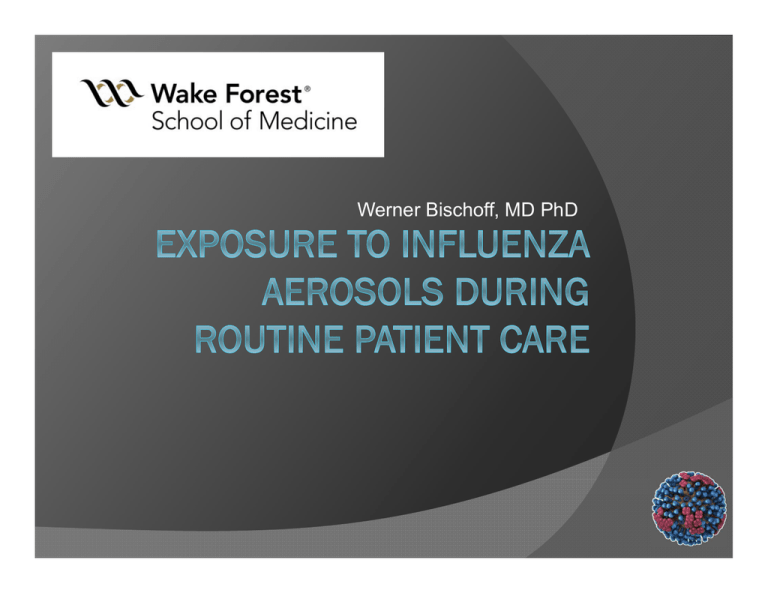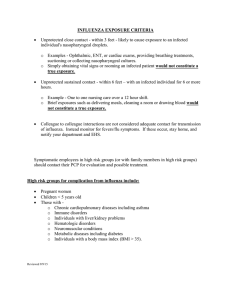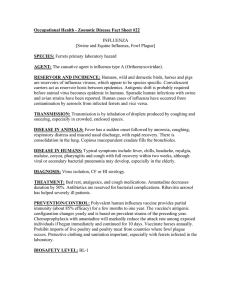Werner Bischoff, MD PhD
advertisement

Werner Bischoff, MD PhD Background Millions have lost their lives to influenza in pandemics Epidemics of varying severity occur worldwide each year. Influenza A H7N9 is the latest threat Current Recommendations (CDC, WHO): Droplet/Contact Precautions since Influenza transmission has been thought to primarily occur by large-particle respiratory droplets. Only during aerosol-generating procedures such as bronchoscopies are fit-tested respirators required. Influenza A H7N9 – airborne plus contact plus eye-protection Objective This study examines: the spatial distribution of influenza aerosols generated by symptomatic patients in a healthcare setting and identifies: clinical features associated with high levels of influenza release. Setting 2010/11 Influenza Season WFBMC is an 885 bed tertiary care teaching hospital Mandatory vaccination policy for all healthcare providers (HCPs) since 2009. During the study season 247 influenza positive patients identified (115 inpatients, 67 clinic patients, 65 ED patients) All test rooms: Turbulent airflow (6 air changes/hour); ANSI/ASHRAE 52.2 compliant endfilters (MERV 15) Methods Patients >2 years of age admitted to the ED or an inpatient care unit with ILI. (documented fever [≥37.8° C] or patient-reported in the past 12 hours, cough/sore throat, and suspected influenza) Demographics, medical/vaccination history, and treatments recorded. Nasopharyngeal swabs obtained from each subject. (bedside rapid testing [BinaxNOW Influenza A&B] and inoculation [BD Diagnostics] for rRT-CR analysis; air samples not obtained from participants negative for influenza by rapid testing) Methods Air Sampling Distance from Patient’s head: 1ft 3ft 6ft Six-stage Andersen air-samplers (AS) 20 minute runs rRT-PCR testing No face/oxygen masks on participants No aerosol generating procedures performed Measures of Illness Symptoms at admission (Likert scale), and days sick Severity of illness and interference with daily life by ILI (VAS) Patient’s coughs/sneezes during air sampling Methods Statistical Analysis Categorical variables - chi square and fisher exact tests Continuous variables - t-tests and Wilcoxon rank sum tests Spatial aerosol distribution - generalized estimating equation model for Poisson distribution with log link function Significance level was set at 0.05 Results Influenza Positivity Ninety-four patients with ILI symptoms enrolled Sixty-one (65%) positive for influenza, 31 carrying influenza A and 30 influenza B Thirty-five subjects underwent air sampling as inpatients, and 26 in the ED Aerosolized influenza detected in 26 (43%) subjects (13 inpatients, 13 ED patients) Rapid testing matched rRT-PCR results of nasopharyngeal and air samples Results Patient Characteristics Influenza-negative vs. positive patients: ○ younger ○ receiving less antiviral therapy ○ more likely enrolled in the ED No significant differences between emitters and non-emitters Influenza specific variables during air sampling Emitters: ○ higher nasopharyngeal viral loads ○ Increased virus release by coughing and sneezing among patients with increased nasopharyngeal viral load only ○ higher severity of illness and interference with daily lives (ED only) Three ED patients admitted to the hospital (sickle cell syndrome (1x), sickle cell with asthma (1x), and foot injury (1x) - none were emitters) Results Influenza RNA copies/10L Respiratory Minute Volume Over 20 Minute Sampling Time 25,000 20,000 15,000 10,000 5,000 High HID50 Threshold (1,950 RNA copies) 0 Low HID50 Threshold (90 RNA copies) Subjects Total Influenza Aerosol Concentrations Emitted by Individual Subjects Results Spatial Distribution of Average Influenza Aerosol Concentrations in Patient Rooms Influenza RNA copies/10L Respiratory Minute Volume over 20 Minutes Sampling Time 600 500 400 Particles ≥4.7 μm 300 Particles <4.7 μm 200 100 0 1ft 3ft Distance from Head of Patient* 6ft *Number of emitters exceeding the low or high HID50 by distance: Low HID50 (>90 RNA copies): 1ft – 13 (50%) out of 26 subjects; 3ft – 11(42%); 6ft – 9(35%) High HID50 (>1,950 RNA copies): 1ft – 3 (12%) out of 26 subjects; 3ft – 2(8%); 6ft – 1(4%) (one emitter can exceed the HID50 at more than one distance) Limitations Study of exposure to influenza aerosols NOT transmission PCR versus virus culture Cross-sectional design – dispersal routes over illness progression? Convenience samples using CDC ILI criteria/rapid test: Exclusion of asymptomatic emitters? Over-enrollment of patients with high amounts of influenza No differentiation of larger particle sizes (>7um) Potential of Influenza aerosols generated by other sources (e.g. HCPs): Type match of swab results with air samples Mandatory vaccination campaign Shedding associated with influenza emission Summary of Key Findings 43% of influenza-infected patients released virus into room air Influenza virus was detected up to 6ft from the patients Virus was predominantly contained in small particles <4.7µm All tests done during non-aerosol-generating patient care activities Dispersal linked to high nasopharyngeal viral load, severity of illness, and impact on daily life Five of the 26 emitters released influenza in exceptionally high concentrations Acknowledgements CDC Division of Healthcare Quality Promotion: Michael Bell, MD David Kuhar, MD Co-investigators: Timothy Peters, MD John Stehle, PhD Iris Leng, MD PhD Katrina Swett, MS Publications: Bischoff WE, Swett K, Leng I, Peters TR. Exposure to Influenza Aerosols during Routine Care. J Infect Dis. 2013;207:1037-46 Bischoff WE, Reid T, Russell GB, Peters TR. Trans-ocular Entry of Seasonal Influenza Attenuated Virus Aerosols and the Efficacy of N95 Respirators, Surgical Masks, and Eye Protection in Human Subjects. J Infect Dis. 2011;204:193-9 Thanks:


